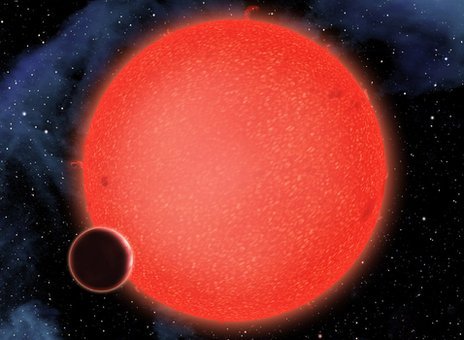
Astronomers using Hubble Space Telescope have confirmed the existence of a new class of planet: a waterworld with a thick, steamy atmosphere.
The exoplanet GJ 1214b is a so-called “Super Earth” – bigger than our planet, but smaller than gas giants such as Jupiter.
Observations using the Hubble telescope now seem to confirm that a large fraction of its mass is water.
The planet’s high temperatures suggest exotic materials might exist there.
“GJ 1214b is like no planet we know of,” said lead author Zachory Berta, from the Harvard Smithsonian Center for Astrophysics.
The planet was discovered in 2009 by ground-based telescopes. It is about 2.7 times the Earth’s diameter, but weighs almost seven times as much. It orbits its red-dwarf star at a distance of just two million km, meaning temperatures on GJ 1214b probably reach above 200C.
In 2010, astronomers released measurements of its atmosphere. These suggested that GJ 1214b’s atmosphere was probably made up of water, but there was another possibility – that the planet was covered in a haze, of the type that envelopes Saturn’s moon Titan.

Zachory Berta and his colleagues used the Hubble Space Telescope’s wide-field camera to study the planet as it crossed in front of its star – a transit. During these transits, the star’s light is filtered through the planet’s atmosphere, giving clues to the mixture of gases present.
The researchers said their results are more consistent with a dense atmosphere of water vapor, than one with a haze.
Calculations of the planet’s density also suggest that GJ 1214b has more water than Earth. This means the internal structure of this world would be very different to that of our own.
“The high temperatures and pressures would form exotic materials like <<hot ice>> or <<superfluid water>>, substances that are completely alien to our everyday experience,” said Dr. Zachory Berta.
The planet’s short distance from Earth makes it a likely candidate for follow-up observations with the James Webb Space Telescope, which may launch by the end of this decade.
The study has been accepted for publication by the Astrophysical Journal.
[youtube 2e7_1ikiNxk]
The subsequent time I learn a weblog, I hope that it doesnt disappoint me as a lot as this one. I imply, I do know it was my choice to read, but I truly thought youd have one thing attention-grabbing to say. All I hear is a bunch of whining about something that you can repair for those who werent too busy searching for attention.